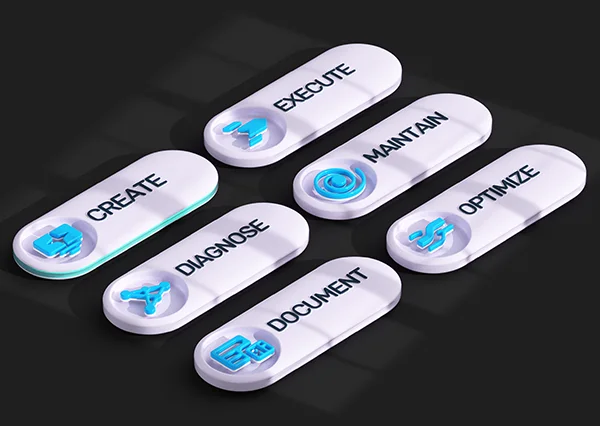The Leader’s Guide to AI Testing Transformation
AI testing can unlock major speed and quality gains, but most organizations struggle to realize them. Many digital transformations fail due to leadership and change-management gaps, not technology. This guide gives enterprise leaders a clear blueprint for moving from brittle, script-based testing to scalable, autonomous AI operations.
You’ll learn:
- Why traditional QA models break down and how AI-native testing changes the equation
- The three-phase roadmap for implementing and scaling AI testing across teams
- Benchmarks from leading enterprises, including 5x productivity, 60 percent faster releases, and 90 percent coverage
- How to build the business case, align stakeholders, and navigate organizational change to ensure success
Download the guide to see how leaders are transforming QA into an autonomous, high-velocity function that supports modern development.
Driving QA Transformation: A Practical Guide for Modern Quality Leaders
Most QA teams are stuck in a cycle of fixing broken scripts, chasing false failures, and fighting to keep automation stable as applications evolve. This guide shows you how to break out of that cycle by shifting away from traditional frameworks that require constant upkeep and toward an AI-driven approach that understands intent, adapts to change, and supports faster and more confident releases. You will learn how leading QA teams are reducing maintenance, increasing coverage, and improving delivery velocity through a structured modernization roadmap.
What’s Inside
- Why legacy automation creates a long-term maintenance burden
- How Agentic AI improves accuracy and stability
- A clear three-phase roadmap for QA transformation
- Real examples of teams that have accelerated release cycles
- How to communicate value and build executive alignment
Download the guide and begin your QA transformation.
The Test Automation Maturity Model
A Roadmap for Transforming Quality from Bottleneck to Strategic Advantage
Software delivery has accelerated faster than traditional QA can keep up. Most organizations are still trapped in script-based automation that demands constant maintenance, limiting speed and scalability. Incremental “AI-assisted” tools may promise relief, but they often automate inefficiency rather than solve it.
This eBook introduces a proven framework for transforming quality into a strategic advantage. You’ll learn how to benchmark your current capabilities, break through the scripting barrier, and design a step-by-step path toward AI-led, self-optimizing testing systems.
Inside, you’ll uncover:
- The five levels of testing maturity, from manual and reactive to fully autonomous
- How to assess your organization’s current state across strategy, people, technology, operations, and governance
- Key transformation milestones that move you from incremental automation to AI-native autonomy
- Best practices from industry leaders achieving 100% test coverage and continuous optimization
The future of quality assurance isn’t about scripts. It’s about systems that think, learn, and adapt.
Generative AI in Software Testing - Trends & Predictions for 2025
Without question, generative AI in software testing for 2025 (and beyond) promises transformative advancements in the field.
In this white paper, you will learn:
Definition and Importance: Generative AI involves machine learning algorithms to generate new data, test cases, or code, enhancing the speed and accuracy of software testing.
Application Areas: It's increasingly used in sectors like healthcare, finance, and design, for tasks like data simulation, risk analysis, and product design.
Evolution of Testing: The paper discusses the historical development of software testing, highlighting the transformation brought by Generative AI.
Technological Innovations: Significant advancements include autonomous test case generation, predictive testing, and integration with DevOps practices.
Future Predictions: For 2025, trends, like augmented intelligent testing, industry-specific customizations, increased cloud-based AI use, and enhanced reporting and analytics, are expected.
Impact on Testing Processes: Generative AI is revolutionizing testing efficiency, quality, and the collaboration between testers and developers.
How Software Agents are Revolutionizing AI-Powered Testing
This guide explores how intelligent agent system autonomously perform tasks, enhance productivity, and streamline operations across various industries.
Learn how Functionize’s innovative agents leverage advanced AI and machine learning to generate, execute, diagnose, maintain and document test cases autonomously. Download now to unleash the full potential of AI in software testing and elevate your testing processes to the next level.
The DevOps guide to testing with Functionize
We show how easily you can integrate Functionize with your existing DevOps workflows. We offer a growing number of native integrations with tools including Jenkins, Jira, PagerDuty, and Xray. This means there is a low bar to entry if you want to transform your DevOps with AI-powered testing.
AI-powered test automation: future-proofing your career for years to come
Digital transformation is a priority for most CEOs. But it causes real issues for your QA team. In any digital transformation, QA teams are under pressure to deliver the green light for every release. But at the same time, the team is trying to stay afloat under the burden of growing test debt. The solution is AI-powered test automation. However, this can sometimes cause your QA team to feel threatened or worried for their jobs. In this white paper, we look at why AI-powered test automation is actually a good thing for everyone involved in QA. Not only can it eliminate test debt completely, it will also help future-proof your job wherever you are on the career ladder.
Top 10 tips for modern web app testing
There was a time when applications were created natively for every platform. Desktop apps were delivered monolithically. Mobile apps were native to each phone platform. Web apps were used for things like eCommerce. Nowadays, we see a very different landscape. Many apps are designed to work cross-platform. There is often no difference between a desktop office app and the web-based version. Sometimes the browser can even replace the OS completely.
This change puts a new emphasis on web UI testing. In this eBook, we will look at the top 10 scenarios for modern web app testing. We will explain what makes them hard, and show how an AI-powered test automation platform allows you to address all 10 scenarios. Finally, we will preview how AI testing will evolve over the coming months and years.
5 Levels of Test Automation
Automation is revolutionizing the worlds of business and IT. The world of testing is no exception. From simple scripts to recorders, and systems that use artificial intelligence, test automation allows testing to be done at scales that were impossible just a few years ago. This is driving the creation of more complex applications and enabling new development models such as CI/CD. In this eBook we discuss how you can assess the level of automation your test tool provides, and we introduce a new model for levels of automation in testing. Using this model will allow you to compare automated testing solutions on a like-for-like basis.
How to demonstrate the value of your automated testing
Your test team faces a conundrum every day. How can they help deliver high-quality software quickly while not wasting money on unnecessary testing? Here, we explore how intelligent test automation can solve this and deliver a good return on investment.
Testing ensures you release quality software that gives your users the best experience. However, there has always been a tension between software quality, speed of delivery, and value for money. The accepted wisdom has been that you can only have two of the three. However, as we will see, intelligent automated testing allows you to have all three. However, before we look at that, we need to understand what testing is, and why it is so expensive.
AI Trends in Testing for 2021 - QA Winter
Will 2021 see the end of the QA winter?
Some years ago, our founder, Tamas Cser, stated that the software industry was stuck in a QA winter. Test automation had languished years behind the rest of the software world. Teams were wasting countless hours writing scripts that then needed constant maintenance. Since then, test automation has evolved significantly. AI-powered testing is making leaps and bounds, test automation is becoming mainstream, and even Selenium is evolving. In this piece, we explore how AI and machine learning will continue to drive improvements in test automation. We will also share our predictions for the year ahead.
How ML underpins Functionize
Software testing has endured, what I term, a QA Winter. Developers and testers still maintain tests the same way they did in the early ages of the internet. Test automation has fallen far behind — and at Functionize we are on a mission to change that.
Why test automation needs machine learning
Software testing has endured, what I term, a QA Winter. Developers and testers still maintain tests the same way they did in the early ages of the internet. Test automation has fallen far behind — and at Functionize we are on a mission to change that.
The death of the selector in automated testing
Ever since Jason Huggins invented Selenium, professional QA testers have relied on selectors to create automated test scripts. However, recent advances in AI and the onset of intelligent test agents may spell the death of the selector. At the very least, in the next few years, selectors will become far richer and more reliable than we are used to.
Here, we explore why the selector has been so important and why we are predicting its demise.
The True Cost of Legacy Testing
Autonomous testing is steadily replacing test automation as the default for UI and web app verification. However, migrating from your old system can seem like an impossible step. Many teams feel they are trapped in a migration Catch 22. They fear that migration will take too much time and effort, disrupting their delivery cycle. But the longer they leave it, the worse this situation becomes. In this whitepaper, we want to show you how easy it is to migrate to Functionize, as well as highlighting the true costs of sticking with your legacy system.
Test Automation Essentials
Why you need it and how to get started
This ebook examines common types of software tests and their evolution alongside common software development practices. It’s an introduction to testing methodologies within an evolving context of bug finding-and-fixing, including both manual and test automation. And it’ll help you understand why test automation is so critical for the modern software development lifecycle.
The Top 10 Reasons Selenium Tests Fail
In this article we will look at the top 10 reasons why Selenium tests fail. We will also show how Functionize offers a better solution that avoids these pain points.

















































































.jpg)
.jpg)
.jpg)
















































